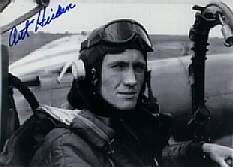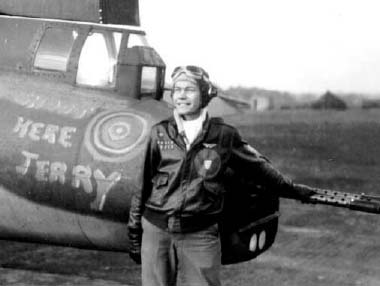 PILOT TALK
PILOT TALK
-November,1998 - April, 1999-   |
E-Mail from Heiden to Carson: Gene, if you or any of our e-mail pals know about or remember the straight of these things, I sure would like to know. When we hang something out there, I feel it should be as true as you can make it and open to revision and criticism. Another topic: I remember flying across bomber fields and too often there were those pillars of black smoke, maybe several. This happened infrequently on fighter bases and I remember it really shook you up. I never hear you and John mention it? --This old memory is like picking a scab-you don't know what comes out! Response From Carson: Art: I think John will agree with me on this one. Two things led to those black pillars of smoke. Pilot error and mechanical malfunctions that took place too late in a take off to allow even the best of pilots to effect corrective action. They were known by a common name, crashes. Take off with a fully loaded B-17 did not allow for less than four good engines. You could get wheels clear at 120mph, but that was the minimum. You could not climb and the end of the runway was never far away. Then too, there were the marginal weather and pre dawn take offs. I suppose that in some cases a dropped wing tip invited a slide off or too much climb was asked of the bird at insufficient air speed. Anyone who has ever flown anything has felt the air craft's reaction immediately before a stall. In a bomber with a full load of bombs at, say one hundred feet altitude such a feeling may well seconds away from kissing you a** goodbye. A couple of dozen teen age or early twenty age pilots at the controls, all moving off hardstands to taxi to the take off end of the runway. Moving bumper to bumper, freeway style. If someone moved too far right or left and off the narrow taxi strip the bomb and fuel heavy aircraft could bog down. The guy behind him might not get stopped. I know you, as an experienced pilot fully understand the turbulence generated after the first few take offs. The guys on subsequent take offs had to fight that turbulence and take off is no time to let a wing tip dip. A crash on the runway could well invite a really large pillar of smoke, two or more with each with ten men gone. I imagine that such scenes were less common on fighter bases because there were fewer contributing causes. Response From Heiden: Suspected same, sure caused an emotional reaction to see it. Prop Wash/wingtip vortices was and has always been a major cause of A/C accidents--often fatal. The larger the A/C the more violent --now we have books of FAA regs on it. We started off with pilots standing out on the runway (marshallers) flagging us off. That scarred me so bad, I started tucking it in on the lead and would lift off slightly before he did, this avoided most of the scary turbulence. Didn't eliminate all the danger though. If someone lost an engine and was wandering all over the runway, someone had to hit the grass. Happened to me once, the guy behind me sure was PO'ed. A response to an e-mail from Art Heiden to Chris Pannell, 55th.FS: You asked my opinion why P-38's had lower victory ratio compared to the single. Here is why I think that the 20th had such a slow beginning in victories: 1) We had no experieced leadership. 2) Our pilots were lacking in aerial gunnery training. 3) We were assigned close escort missions where we were not supposed to leave the bombers to chase the enemy. 4) Easy recognition of the P-38 by the enemy who avoided us in favor of unprotected bombers. 5) A shortage of pilots and aircraft at times. Our maintenance people were working around the clock changing engines, etc. to get enough planes available. I think the P-38's did very well after we overcame the growing pains. -- Chris Pannell, 55th.FS Art, Please tell us. How did that bird handle on take off when so loaded? Also it would seem that banks might have to be a bit on the shallow side...How much extra runway was required and what might be the disasterous results of a fail power plant with such a load. Chance of survival? Also when loaded that way what was the range? Should be very interesting. Response from Heiden First, the 8thAF P-38's didn't use those 2K bombs or 300 Gal. tanks. We only had 1K's and 165gal. tanks. Pacific theater did use them. King's Cliffe was a most primitive airfield with 3400' runways, which every foot was used under certain conditions. There was a hedge across the end of north runway. It had marks where wheels had gone through it. Sometimes our load was one tank and one 1K bomb. Next, we didn't have all those fancy performance charts that have to be developed under today's Regs. Our procedure for losing an engine on T/O was if below 120mph was Cut Power and land straight ahead. If between 120 and 140, power must be reduced to maintain control on Single Engine. If 140 or above you could maintain control with Full power and full rudder. Single Engine Rates of climb weren't available. Believe that this business of 2K's and 300gal. tanks were only used on 38L's which had more power. Would have to review the charts to have any idea. Again, WWII charts were very limited. P-38 had an exceptional wing for lift. Don't remember a situation when it felt like it was staggering. Just used more runway. Of course, weight would reduce S/E climb rate. Most AF regs would prohibit operations if S/E climb rates were 50 feet per min or less. Structural limitations in AF could be reduced to 2.5 G's. FAA regs deal with these circumstances differently. Art E-mail from Col. Carson, April 28,1999 I have witnessed many, perhaps a dozen or more mid air collisions, usually
with a loss of all on board. I have also witnessed bombs dropping on another
B-17. Many of the collisions were due to bad weather and pilot error. Many were,
again minimal visibility on take off and too many other aircraft reaching for
the same air space. There is not a pilot alive who flew during those combat
days in the ETO who will not recall instrument take offs, climbing blind and
hoping to breakout before making contact with something hard in the clouds. Reply from Capt. Heiden John C,(John Carson, brother of Gene, who was a B-17 crewman in the 15th.AF) can tell you the feeling, and remembers well when his tin can blew
apart. I can tell you its violent, from my experience. But, in a single seat,
you are close to the structure and when things settle down to a snap
maneuver, your strength will let you get your arms and legs in use to pry
yourself out against the G-forces. Response from Col. Carson. Art, I would expect that in the smaller airframe there would be a better chance of extracating one's self despite the G Forces. While in a B-17, once in the tail and once in the cockpit I experienced the force of a spin. You just sort of hang on. How John (Carson's brother) ever got out was nothing but a miracle. I also recall a few dives to put out a fire. On pull out the entire airframe seemed to talk to you, I swear it groaned. |
RETURN TO A TRIBUTE TO CAPT. HEIDEN
AN INTERVIEW WITH CAPT.HEIDEN
CAPT. HEIDEN TALKS ABOUT THE P-38 AND P-51
A LETTER FROM CAPT. HEIDEN TO MARTIN CAIDIN
RETURN TO THE 20TH.FG
Unless otherwise noted, all content © copyright The Art of Syd Edwards 1998-1999. All rights reserved and reproduction is prohibited.
